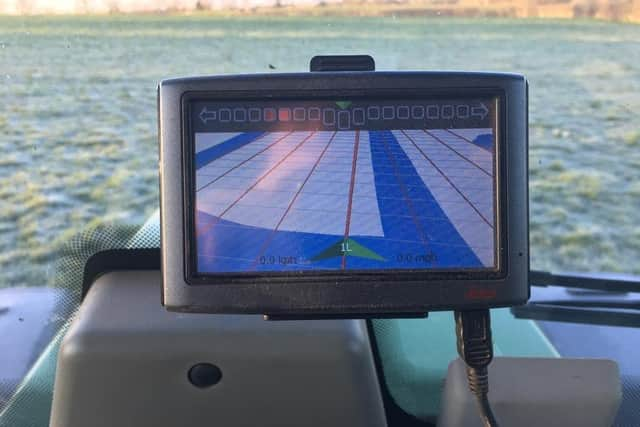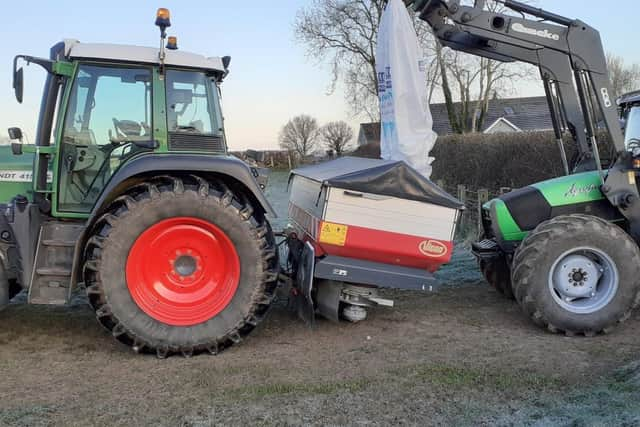Set your fertiliser sower – at current prices waste is expensive!


Brian Hanthorn, CAFRE Beef and Sheep Adviser, Dungannon, outlines the principles of getting the most from your machine.
Sower Type
Fertiliser sowers on Beef and Sheep farms generally fall into three categories :- Oscillating Spout (Wagtail type), Single disc and Double Disc. Single disc sowers are commonly found being towed behind quad bikes and they are generally quite limited in their spreading width.Double or twin disc sowers are very popular and have the advantage of wider sowing width and a more even sowing pattern compared to some single disc sowers. Oscillating spouts sowers are more commonly known as wagtail sowers and remain very popular on beef and sheep farm due to ease of set up and simplicity of use.


Attaching the sower
Advertisement
Advertisement
When attaching the sower to the tractor linkage it is important to know the height settings for the sower. Many oscillating spout sowers are 75 cm from the centre of the linkage to the top of the crop, also 75 cm from the centre of the oscillating spout to the top of the crop. This will ensure the sower is attached perfectly level. Double disc sowers will have their individual settings according to brand or manufacturer and these can be found in the handbook. Note that the settings may be from the top of the crop and not actual ground level.
Check the sower
After attaching the sower give it a quick check around to ensure all hydraulic rams and moving parts actually do what there are designed to do. Grease the sower on all parts that are labelled and check everything is working properly.


Decide on a suitable forward speed
The forward speed should be selected according to the land type and conditions as well as considering slopes and hills. Fertiliser sowers have become considerably larger in the last ten years with many holding 3-4 tonnes, and a lot of this weight is carried quite high behind the tractor which can result in the tractor being less stable. The forward speed of tractors at 540 rpm on the PTO can be obtained from the chart generally somewhere on the dash or cab of the tractor, or in the operator’s manual for the tractor. Oversize tyres, if fitted, will affect the forward speed. Some modern tractors will display the forward speed beside the engine speed. Global Positioning Systems (GPS) are becoming increasingly popular and will give a very accurate forward speed.
Setting the sower and sowing width
Most common sowers categorise fertiliser into ordinary granular fertiliser or prills such as urea. Many advanced sowers require the brand of fertiliser and the type as these all influence flow rate and spreading width.
Advertisement
Advertisement
Once the desired fertiliser has been selected at the amount required per acre or per hectare then spreading width is needed. Spreading width on most beef and sheep farms is generally between 10-18 metres. Some contractors can sow wider than this with very precise and accurate sowers. Spreading width can be altered on oscillating spout sowers by increasing or decreasing the angle of spout travel. Some more advanced double disc sowers can have adjustable vanes on the discs which alters the angle to increase or decrease spreading width. The handbook will outline the specifics of each machine, however it is important to select a width that the operator feels comfortable and confident with. The increasing use of GPS has facilitated an increase in spreading width which speeds up the operation and improves accuracy. GPS clearly displays where to drive and the areas of the field which have already received fertiliser.
To set the sower, first find the calibration table or chart for your sower which will be in the handbook and occasionally on the sower itself. Making sense of this table requires generally three pieces of information which are:- type of fertiliser, forward speed and spreading width. When this information is fed into the chart, it will give a number setting for the sower. A phone app may also be available for very modern sowers to obtain this information.
After initial setup the sowing is relatively straight forward provided the spreading width is adhered to and the tractor is going at the desired forward speed at 540 RPM on the PTO shaft. If in doubt sow a small field with the correct amount of fertiliser in the hopper and see how accurate it is.
Care of the sower after spreading
To ensure a long working life of the fertiliser sower it is essential to wash it thoroughly at the end of each day. Fertilisers are very corrosive substances which will quickly corrode the machine if not properly looked after.